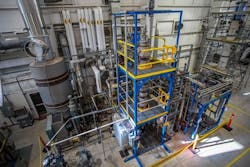U.S. Steel pursuing Carbon Capture technology for largest plant Gary Works
Historic alloy producer U.S. Steel will work with a carbon capture specialty firm to pursue the reduction and mineralization of up to 50,000 metric tons of carbon dioxide annually emitted at the steel maker’s Gary Works manufacturing plant in Indiana.
CarbonFree Holdings signed a non-binding memorandum of understanding with U.S. Steel to use the former’s SkyCycle technology at the Gary Works. SkyCycle is designed to directly capture CO2 emissions from the industrial processes.
CaronFree has spent the past 17 years doing research and development on the SkyCycle system to capture and then convert the CO2 into specialty chemical precipitated calcium carbonate (PCC) and hydrochloric acid as a co-product. PCC is used in the construction industry as a building material, while hydrochloric acid is in used in other industrial processes such as refining metal.
“We are eager to enter the next phase of discussions with CarbonFree to explore the possibility of meaningful CO2 emission reductions in our operations in a capital efficient manner,” said Richard L. Fruehauf, SVP – Chief Strategy & Sustainability Officer at U. S. Steel, in a statement. “Working with CarbonFree could be a meaningful step in our efforts to decarbonize the Gary Works plant while developing technology and know-how that we could apply to other facilities within our footprint. These potential collaborations are critical to U. S. Steel as we continue our mission of providing profitable steel solutions for people and planet.”
If successful in capturing and repurposing 50,000 metric tons of CO2 annually, that would be the equivalent of removing carbon emissions from nearly 11,000 passenger vehicles, according to the report.
Gary Works is U.S. Steel’s largest manufacturing plant, capable of producing 7.5 million net tons of raw steel per year. Sheet, rolled, plates and galvanized metal and tin are produced at the facility, supplying such customers as the automotive, building, and appliance markets.
Read EnergyTech's full coverage of Carbon Capture projects
U.S. Steel also teaming with Shell Gas and Equinor on Carbon Capture and Hydrogen Hub
Subscribe to EnergyTech's free newsletter for Everyday Insights into the C&I Energy Transition
“As we aim to widely introduce and scale our technology to industrial facilities across the globe, we are thrilled for the possibility of bringing our SkyCycle technology’s carbon capture capabilities to U. S. Steel’s Gary Works plant, one of the largest integrated steel mills in North America,” said Martin Keighley, CEO of CarbonFree. “We are committed to working closely with U. S. Steel to achieve their sustainability goals and to further our mission of helping to enable the world’s transition to net zero carbon emissions.”
CarbonFree and U.S. Steel hope to come to a final agreement later this year. Both parties are hoping to begin carbon capture and mineralizing operations by 2025.
If the collaboration reaches commercial scale with markets for the byproducts, then another projects could follow, the companies say.
The nation's industrial sector generates about 25 percent of the greenhouse gas emissions released throughout the U.S., according to federal statistics.
China is the world’s largest steel producer. In the U.S. however, domestic raw steel production averages more than 1.5 million net tons per week.
-- -- --
(Rod Walton, senior editor for EnergyTech, is a 15-year veteran of covering the energy industry both as a newspaper and trade journalist. He can be reached at [email protected]).
Follow us on Twitter @EnergyTechNews_ and @rodwaltonelp and on LinkedIn
About the Author
Rod Walton, EnergyTech Managing Editor
Managing Editor
For EnergyTech editorial inquiries, please contact Managing Editor Rod Walton at [email protected].
Rod Walton has spent 17 years covering the energy industry as a newspaper and trade journalist. He formerly was energy writer and business editor at the Tulsa World. Later, he spent six years covering the electricity power sector for Pennwell and Clarion Events. He joined Endeavor and EnergyTech in November 2021.
Walton earned his Bachelors degree in journalism from the University of Oklahoma. His career stops include the Moore American, Bartlesville Examiner-Enterprise, Wagoner Tribune and Tulsa World.
EnergyTech is focused on the mission critical and large-scale energy users and their sustainability and resiliency goals. These include the commercial and industrial sectors, as well as the military, universities, data centers and microgrids. The C&I sectors together account for close to 30 percent of greenhouse gas emissions in the U.S.
He was named Managing Editor for Microgrid Knowledge and EnergyTech starting July 1, 2023
Many large-scale energy users such as Fortune 500 companies, and mission-critical users such as military bases, universities, healthcare facilities, public safety and data centers, shifting their energy priorities to reach net-zero carbon goals within the coming decades. These include plans for renewable energy power purchase agreements, but also on-site resiliency projects such as microgrids, combined heat and power, rooftop solar, energy storage, digitalization and building efficiency upgrades.

